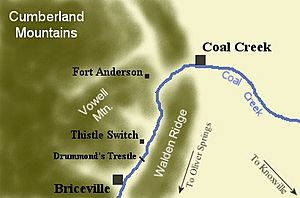Coal Creek War facts for kids
Quick facts for kids Coal Creek War |
|||
|---|---|---|---|
| Part of the Coal Wars | |||

Key locations during the Coal Creek War
|
|||
| Date | April 1891 – August 1892 | ||
| Location | |||
| Goals | End convict leasing by coal companies | ||
| Resulted in | State ending convict leasing in 1896 | ||
| Parties to the civil conflict | |||
|
|||
| Lead figures | |||
|
|||
| Casualties | |||
|
|||
The Coal Creek War was a major conflict that happened in the early 1890s in Anderson County, Tennessee. It was a fight between coal miners and coal companies. The miners were very upset because the companies started using prisoners for labor instead of paying regular workers. This led to many miners losing their jobs or having their wages cut.
This event is seen by some historians as "one of the most dramatic and significant episodes in all American labor history."
Contents
The Coal Creek War
Why the War Started
The Coal Creek War began in April 1891. Coal mine owners in the Coal Creek area started replacing their paid miners with prisoners. These prisoners were "leased" from the Tennessee state prison system. This system, called convict leasing, allowed the state to rent out prisoners to private companies.
The companies liked this because they didn't have to pay the prisoners wages. This meant they could pay their regular workers less, or even fire them. This practice made it hard for free miners to find good jobs. It also lowered wages for everyone.
The Conflict Unfolds
The upset Coal Creek miners fought back. They attacked and burned down state prison camps. They also destroyed mine properties. Hundreds of state prisoners were freed from their forced labor by the miners.
Many miners were hurt or killed in small fights during this time. Dozens of Tennessee state militia members were also injured or died. The conflict drew a lot of attention. It sparked a big public debate about the convict-leasing system. People across the state took sides.
How the War Ended
The Coal Creek War mostly ended in 1892. Hundreds of the former company coal miners were arrested. However, the widespread attention the conflict received had a big impact. It led to the downfall of Governor John P. Buchanan.
The conflict also forced the Tennessee General Assembly (the state's government) to rethink its convict-leasing system. When the contracts with private businesses ended in 1896, the Tennessee state government decided not to renew them. This made Tennessee one of the first states in the southern United States to stop this controversial practice.
Lasting Impact
The Coal Creek War left a lasting mark on the area. The Coal Creek Watershed Foundation works to preserve the history of this conflict. They have found the remains of Fort Anderson and unmarked graves of convicts.
Much of the land bought by the state in 1896 for a new prison is now part of Frozen Head State Park.
Music and Memory
The Coal Creek War also inspired some of the earliest Appalachian coal mining protest songs.
- "Coal Creek Troubles" was written after the conflict. Jilson Setters recorded it in 1937.
- "Coal Creek March" is a popular banjo tune. Pete Seeger recorded it for the Library of Congress in 1938. It's still played by bluegrass musicians today.
- The song "Buddy Won't You Roll Down the Line" was based on the Coal Creek War. It was written and performed by Grand Ole Opry pioneer Uncle Dave Macon.

